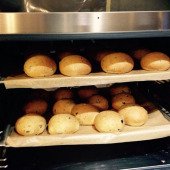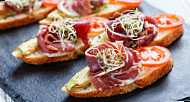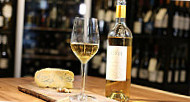
Telefono: +493025796751
Indirizzo: Kreuzberg & Neukölln, Jüdisches Museum, Lindenstrasse 9-14, 10969, Berlin, Germany
Città: Berlin
Menu Piatti: 19
Recensioni: 726
"19.02.2015 Everywhere you will find traces of Jewish life and Jewish culture when you look closely. Like a germinating seed... delicate... vulnerable... again or even more? synagogues, cemeteries, but also stumbling stones that call the names of deported and murdered Jews during Nazism. Nowhere, however, as in this largest Jewish museum in Europe, one finds such a detailed and interesting representation of Jewish history in Germany, as here. This is not only about discrimination, persecution and the Holocaust, but about Jewish culture, its customs, customs, famous personalities and the development of Jewish society in Germany over more than a millennium and the various eras. Shortly before the seizure of power of the National Socialists, the first Jewish Museum in Berlin was opened in 1933. In 1938 it was closed by the Gestapo. For the first time in 1971 a Jewish museum opened in Berlin. It was opened in 2001. To take it forward: The visit to this museum is absolutely recommended. The very high price of 8 € per adult is more than reasonable. The museum is located in two underground buildings, namely the Baroque old building of the College House of 1735 and the modern construction according to a design by American architect Daniel Libeskind. It would blow the scope of the assessment to describe the outer and inner architecture here in detail. In this respect, I refer to my photo track, which is merely an attempt to depict the great and extraordinary symbiosis of architecture and exhibition. On a Sunday we began to devote a day to Jewish culture in Berlin and visit some places related to it, including the museum, whose architecturally unusual form of Libeskind Bau fascinated me from the outside and made me curious about the interior. The safety precautions in the entrance area were very strict, comparable to those at an airport. The transition from the entrance building to Libeskind Bau, in which the permanent exhibition is located, forms a steep staircase leading to the depth of the building. At the bottom, you will find yourself on the axis of continuity, which runs as an ascent gear and opens into an equally steep staircase to the permanent exhibition. There are also chairs, of course, so the museum is accessible. On the right of the axis of continuity, the Rafael Roth Learning Center, in which a wide range of media during our visit invited some young people to deal more closely with Jewish culture. As soon as we met the crossing axis of the exile with the garden of the exile, which is reminiscent of the Holocaust Mahnmal near the Brandenburg Gate. One more piece crossed the axis of the Holocaust. The fate of the person concerned is told in each case to the objects exhibited in shop windows, which were once owned by murdered people of Jewish faith. Our grasp of this was a cold shower and a pressure when we entered the Holocaust Tower through a metal door. Ice cold hit us. The look up revealed a powerful height. The darkness causes an extremely jamming feeling in us. We went back and immediately up a staircase, on whose half height the Eric F. Ross gallery and empty space (with double e) branches off the memorial. An installation is located in an entrance hall. A writing robot is currently writing a huge Tora role, letter for letter in Hebrew. In the space of commemoration, we entered the installation Schalechet (falling foliage) by Israeli artist Menashe Kadishman. We stick to the faces of infinitely many large and small faces with broken metal mouths, which can also be lifted up and removed elsewhere. An unpleasantly shrill metallic sound, which in the likewise high tower sounds sharply, in the otherwise prevailing silence of the dead makes us uncomfortable in our ears. If they weren't made up of metal, but of photographs, or if they were made of meat and blood, would we have been on them? It's an experiment with our psyche... thoughtfully, we leave the room, not without the sight of the camera. Almost facilitated, we enter another floor of higher knowledge the permanent exhibition, beginning with the world of Ashkenas 950 1500, as a result of Jewish communities blooming in today's Germany. It then rejoices department around division: women's lives 1646 1724: the oldest preserved memories of the Jewish woman Glikl bas Judah Body, causes of faith, city, land and court 1500 1800: The life of the Jews on the land and at Hofe, Moses Mendelsohn and the Enlightenment 1750 1800, Tradition and Change, family life 1850 1933, Germans and Jews at the same time 1800 1914, Modern Judaism 1800 1933, Berlin 1890 1933, East and West 1900 1933, endangered equality in 1914 1933, a children's island : an exhibition for children, National Socialism in 1933 and present 1945 today. Did I forget something? Most visitors can be found in the area where the fate of the Jews is represented and documented during the time of National Socialism. Too often, however, I have been busy with this time so that it is not necessarily the most interesting part of the permanent exhibition for me. In other exhibition areas I can take a lot more interesting and new things for me. After about 2 3 hours, we finished our tour and dive too deeply from the world of Jewish history and re-entered to the present time with the utmost respect for Jewish culture. It is a sunny but freezing winter day. A day many Jews in Germany could have enjoyed if they had experienced him at the age, they would not have become victims of the Holocaust. When we walk through the springy sun outside, a thought comes to a very special person, a Jewish girl whose destiny symbolically stands for countless Jewish children and young people... there is a place in Berlin that thinks of her where you can enter her world... we quickly went to the car and drove to Rosenthaler Straße. There we were looking for house number 39..."
Menu completo - 19 opzioni
Tutti i prezzi sono stime su Menu.
Frühstück Servieren Wir Bis 14:00 Uhr
Piccole Delizie
Salate
Insalate
Frühstück Servieren
Pasta
Dessert
Le Boulanger - The Baker
Menù Stagionale
Dolci Prelibatezze
Menu Stagionale
Indirizzo

Recensioni
Berlin

Berlino, capitale della Germania, fonde storia e modernità; goditi il currywurst e il döner kebab, iconici cibi di strada che riflettono la sua scena culinaria diversificata.
Categorie
-
Kaffee Concediti la nostra ricca e aromatica selezione di caffè, sapientemente preparata per risvegliare i tuoi sensi. Dal classico espresso ai cremosi cappuccini, scopri la miscela perfetta per iniziare la giornata con una nota di sapore.
-
Jüdisch Vivi il calore della cucina tradizionale ebraica, offrendo una deliziosa gamma di piatti che fondono sapori ricchi e gusti confortanti, dal pastrami saporito alla dolce challah, celebrando il patrimonio e l'arte culinaria. Visualizza piatti
-
Mittagessen Soddisfa i tuoi desideri di mezzogiorno con il nostro delizioso menu per il pranzo. Dalle insalate fresche e i panini sostanziosi alle zuppe saporite e alle ciotole vibranti, ogni piatto è creato per darti la perfetta carica a metà giornata.
-
Vegetarisch Goditi la nostra vibrante collezione di piatti vegetariani, realizzati con le verdure più fresche, sapori ricchi e spezie saporite. Gustati un piatto salutare e delizioso che celebra i migliori ingredienti della natura.
Servizi
-
W-lan
-
Im Freien
- Piatti
-
Fernsehen
- Menu
-
Sitzplätze










